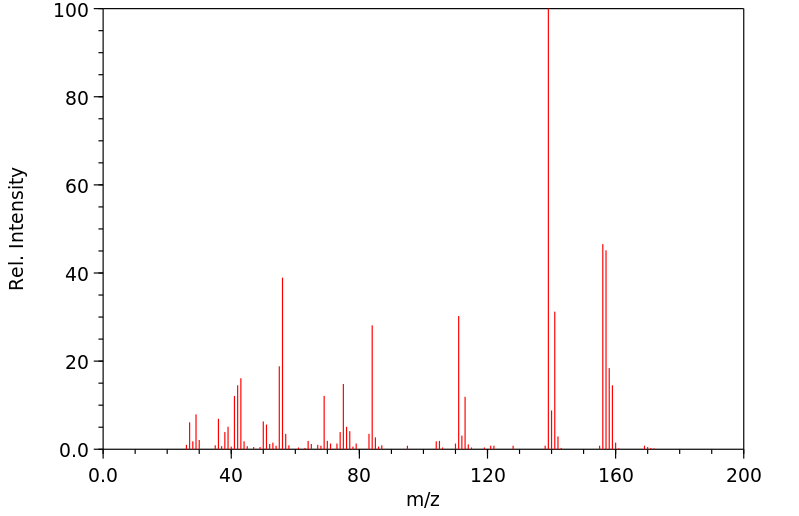4-氯苯甲酸己酯 | 58435-21-5
中文名称
4-氯苯甲酸己酯
中文别名
——
英文名称
hexyl 4-chlorobenzoate
英文别名
——
CAS
58435-21-5
化学式
C13H17ClO2
mdl
——
分子量
240.73
InChiKey
WNIDDGDBCDWAIE-UHFFFAOYSA-N
BEILSTEIN
——
EINECS
——
-
物化性质
-
计算性质
-
ADMET
-
安全信息
-
SDS
-
制备方法与用途
-
上下游信息
-
文献信息
-
表征谱图
-
同类化合物
-
相关功能分类
-
相关结构分类
物化性质
-
保留指数:1714;1725;1734;1716;1726;1735
计算性质
-
辛醇/水分配系数(LogP):5.3
-
重原子数:16
-
可旋转键数:7
-
环数:1.0
-
sp3杂化的碳原子比例:0.46
-
拓扑面积:26.3
-
氢给体数:0
-
氢受体数:2
SDS
上下游信息
反应信息
-
作为反应物:描述:三乙基(三氟甲基)硅烷 、 4-氯苯甲酸己酯 在 potassium fluoride 、 2-(二环己基膦)3,6-二甲氧基-2′,4′,6′-三异丙基-1,1′-联苯 、 [(allyl)PdCl]2 作用下, 以 1,4-二氧六环 为溶剂, 以85%的产率得到hexyl 4-(trifluoromethyl)benzoate参考文献:名称:钯催化芳基氯化物的三氟甲基化反应摘要:三氟同时存在 三氟甲基 (CF3) 基团在药物和农用化学品的设计中发挥着越来越重要的作用。CF3 是给定分子框架内电子密度的强大吸引子,最近氟烃相互作用已成为对更传统的亲水/疏水相互作用的独特补充,后者控制小分子和蛋白质之间的对接。Cho 等人。(p. 1679) 现在提出了一种将 CF3 基团附加到各种芳基底物的有效方法。精心优化的钯催化剂能够加快一个关键的消除步骤,该步骤一直困扰着以前为实现这一合成挑战的通用解决方案而做出的努力。仔细的催化剂调整可以将三氟甲基添加到药物和农用化学品合成中的许多中间体中。三氟甲基可以显着影响有机分子的性质,从而提高它们作为药物、农用化学品或有机材料构建块的适用性。尽管该取代基很重要,但没有将其安装到官能化芳族底物上的通用方法。当前的方法要么需要使用苛刻的反应条件,要么受到底物范围有限的影响。在这里,我们报告了在温和条件下钯催化的芳基氯的三氟甲基化,允许以DOI:10.1126/science.1190524
-
作为产物:描述:对氯苯甲酸 以21%的产率得到参考文献:名称:KUDO TADAHIRO; NOSE ATSUKO, YAKUGAKU DZASSI, YAKUGAKU ZASSNI, J. PHARM. SOS. JAR.
, 1975, 95+ 摘要:DOI:
文献信息
-
以N-Boc酰胺为原料合成酯类化合物的制备方法
-
Studies of the Electronic Effects of Zinc Cluster Catalysts and Their Application to the Transesterification of β‐Keto Esters作者:Kazushi Agura、Yukiko Hayashi、Mari Wada、Daiki Nakatake、Kazushi Mashima、Takashi OhshimaDOI:10.1002/asia.201600062日期:2016.5.20The electronic effects of tetranuclear zinc cluster catalysts on transesterification were investigated by changing the carboxylate ligands in the clusters. High catalyst activity crucially depended on the balance between Lewis acidity and Brønsted basicity of the catalyst; this was consistent with the dual activation of both the electrophile and nucleophile by the cooperative zinc centers. In addition
-
Cesium Carbonate Catalyzed Esterification of <i>N</i>-Benzyl-<i>N</i>-Boc-amides under Ambient Conditions作者:Danfeng Ye、Zhiyuan Liu、Hao Chen、Jonathan L. Sessler、Chuanhu LeiDOI:10.1021/acs.orglett.9b02513日期:2019.9.6We report a general activated amide to ester transformation catalyzed by Cs2CO3. Using this approach, esterification proceeds under relatively mild conditions and without the need for a transition metal catalyst. This method exhibits broad substrate scope and represents a practical alternative to existing esterification strategies. The synthetic utility of this protocol is demonstrated via the facile synthesis of crown ether derivatives and the late-stage modification of a representative natural product and several sugars in reasonable yields.
-
Oxyfunctionalization of Aliphatic Esters by Methyl(trifluoromethyl)dioxirane作者:Gregorio Asensio、Gloria Castellano、Rossella Mello、M. E. González NúñezDOI:10.1021/jo9604189日期:1996.1.1The oxidation of lineal, cyclic, and bicyclic aliphatic p-chlorobenzoic and p-chorobenzenesulfonic acid esters 2 with methyl(trifluoromethyl)dioxirane (TFDO) (1) occurs at positions in the hydrocarbon chain distant from the directing group with a significant degree of selectivity to give the corresponding keto or hydroxy esters. Compounds 2 are relatively deactivated with respect to this oxidation due to the electron-withdrawing nature of the ester moiety. Methylene C-alpha-H and C-beta-H bonds remain unchanged in all cases, but tertiary C-beta-H bonds undergo oxidation with TFDO (1). Stereoelectronic factors are used to explain the faster reaction rate in competition experiments for the oxidation of endo-norbornyl ester 2h than for its exo-isomer 2g.
-
HUANG, HUAMIN;ZHU, SHAOXIAN;QI, WANSHAN;NA, CHONGWU, ACTA SCI. NATUR. UNIV. JILINENSIS,(1987) N 4, 71-75作者:HUANG, HUAMIN、ZHU, SHAOXIAN、QI, WANSHAN、NA, CHONGWUDOI:——日期:——
表征谱图
-
氢谱1HNMR
-
质谱MS
-
碳谱13CNMR
-
红外IR
-
拉曼Raman
-
峰位数据
-
峰位匹配
-
表征信息
同类化合物
(βS)-β-氨基-4-(4-羟基苯氧基)-3,5-二碘苯甲丙醇
(S,S)-邻甲苯基-DIPAMP
(S)-(-)-7'-〔4(S)-(苄基)恶唑-2-基]-7-二(3,5-二-叔丁基苯基)膦基-2,2',3,3'-四氢-1,1-螺二氢茚
(S)-盐酸沙丁胺醇
(S)-3-(叔丁基)-4-(2,6-二甲氧基苯基)-2,3-二氢苯并[d][1,3]氧磷杂环戊二烯
(S)-2,2'-双[双(3,5-三氟甲基苯基)膦基]-4,4',6,6'-四甲氧基联苯
(S)-1-[3,5-双(三氟甲基)苯基]-3-[1-(二甲基氨基)-3-甲基丁烷-2-基]硫脲
(R)富马酸托特罗定
(R)-(-)-盐酸尼古地平
(R)-(-)-4,12-双(二苯基膦基)[2.2]对环芳烷(1,5环辛二烯)铑(I)四氟硼酸盐
(R)-(+)-7-双(3,5-二叔丁基苯基)膦基7''-[((6-甲基吡啶-2-基甲基)氨基]-2,2'',3,3''-四氢-1,1''-螺双茚满
(R)-(+)-7-双(3,5-二叔丁基苯基)膦基7''-[(4-叔丁基吡啶-2-基甲基)氨基]-2,2'',3,3''-四氢-1,1''-螺双茚满
(R)-(+)-7-双(3,5-二叔丁基苯基)膦基7''-[(3-甲基吡啶-2-基甲基)氨基]-2,2'',3,3''-四氢-1,1''-螺双茚满
(R)-(+)-4,7-双(3,5-二-叔丁基苯基)膦基-7“-[(吡啶-2-基甲基)氨基]-2,2”,3,3'-四氢1,1'-螺二茚满
(R)-3-(叔丁基)-4-(2,6-二苯氧基苯基)-2,3-二氢苯并[d][1,3]氧杂磷杂环戊烯
(R)-2-[((二苯基膦基)甲基]吡咯烷
(R)-1-[3,5-双(三氟甲基)苯基]-3-[1-(二甲基氨基)-3-甲基丁烷-2-基]硫脲
(N-(4-甲氧基苯基)-N-甲基-3-(1-哌啶基)丙-2-烯酰胺)
(5-溴-2-羟基苯基)-4-氯苯甲酮
(5-溴-2-氯苯基)(4-羟基苯基)甲酮
(5-氧代-3-苯基-2,5-二氢-1,2,3,4-oxatriazol-3-鎓)
(4S,5R)-4-甲基-5-苯基-1,2,3-氧代噻唑烷-2,2-二氧化物-3-羧酸叔丁酯
(4S,4''S)-2,2''-亚环戊基双[4,5-二氢-4-(苯甲基)恶唑]
(4-溴苯基)-[2-氟-4-[6-[甲基(丙-2-烯基)氨基]己氧基]苯基]甲酮
(4-丁氧基苯甲基)三苯基溴化磷
(3aR,8aR)-(-)-4,4,8,8-四(3,5-二甲基苯基)四氢-2,2-二甲基-6-苯基-1,3-二氧戊环[4,5-e]二恶唑磷
(3aR,6aS)-5-氧代六氢环戊基[c]吡咯-2(1H)-羧酸酯
(2Z)-3-[[(4-氯苯基)氨基]-2-氰基丙烯酸乙酯
(2S,3S,5S)-5-(叔丁氧基甲酰氨基)-2-(N-5-噻唑基-甲氧羰基)氨基-1,6-二苯基-3-羟基己烷
(2S,2''S,3S,3''S)-3,3''-二叔丁基-4,4''-双(2,6-二甲氧基苯基)-2,2'',3,3''-四氢-2,2''-联苯并[d][1,3]氧杂磷杂戊环
(2S)-(-)-2-{[[[[3,5-双(氟代甲基)苯基]氨基]硫代甲基]氨基}-N-(二苯基甲基)-N,3,3-三甲基丁酰胺
(2S)-2-[[[[[((1S,2S)-2-氨基环己基]氨基]硫代甲基]氨基]-N-(二苯甲基)-N,3,3-三甲基丁酰胺
(2S)-2-[[[[[[((1R,2R)-2-氨基环己基]氨基]硫代甲基]氨基]-N-(二苯甲基)-N,3,3-三甲基丁酰胺
(2-硝基苯基)磷酸三酰胺
(2,6-二氯苯基)乙酰氯
(2,3-二甲氧基-5-甲基苯基)硼酸
(1S,2S,3S,5S)-5-叠氮基-3-(苯基甲氧基)-2-[(苯基甲氧基)甲基]环戊醇
(1S,2S,3R,5R)-2-(苄氧基)甲基-6-氧杂双环[3.1.0]己-3-醇
(1-(4-氟苯基)环丙基)甲胺盐酸盐
(1-(3-溴苯基)环丁基)甲胺盐酸盐
(1-(2-氯苯基)环丁基)甲胺盐酸盐
(1-(2-氟苯基)环丙基)甲胺盐酸盐
(1-(2,6-二氟苯基)环丙基)甲胺盐酸盐
(-)-去甲基西布曲明
龙蒿油
龙胆酸钠
龙胆酸叔丁酯
龙胆酸
龙胆紫-d6
龙胆紫







